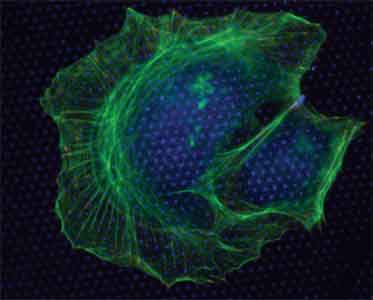Gardel, 2008 Packard Fellow, studies protein behaviors through models
By Greg Borzogregborzo@uchicago.edu
News Office
 Photo by Jonathan Stricker Biological cells are composed of proteins that self-assemble into materials that enable cells to move and respond to external mechanical forces. This immunofluorescence image of a cancer cell, taken with an epifluorescent microscope, depicts some of those materials: actin cytoskeleton (green), which is the dynamic structure of the cell; and focal adherents (red), where actin bundles, as well as external proteins, attach to the cell. The external proteins are shown in blue. |
|
When Margaret Gardel talks about mixing and matching, she’s probably not discussing her wardrobe. The Assistant Professor in Physics, winner of a 2008 Packard Fellowship, is more likely to be talking about proteins.
Her work, which focuses on the physics of soft condensed matter, involves studying how cells use proteins to structure themselves. To this end, Gardel and her team purify proteins from various sources and mix them to form new assemblies. The goal is to reconstitute structures that look like the ones that proteins form in living cells.
“By emulating what we see in nature, we can create models to study the physical properties and behaviors of such meshworks,” Gardel said.
This knowledge could have some practical applications, such as harnessing proteins to do mechanical work.
“Biological and evolutionary forces have developed proteins that can do amazing things—things that inert matter cannot do,” Gardel explained. “If we could better understand what governs a cell’s elasticity and contractility, we might be able to put proteins to work building or fixing things, even in the human body.”
For example, many diseases, such as asthma and the metastasis of cancer, are associated with faulty mechanical outputs on the cellular level, Gardel said. “If we knew how proteins build cell structure, we would be more likely to find the proteins that have ‘gone wrong.’”
The fellowship from the David and Lucile Packard Foundation will help Gardel study such issues, as well as how adherent, animal cells sense, transmit and generate mechanical forces. “This work will elucidate the basic physical principles underlying force transmission of living cells and establish novel frameworks for non-biological materials,” she said.
Gardel is one of 20 scientists and engineers to win a Packard fellowship this year, the 20th anniversary of the program. The $875,000 “no-strings-attached” grant spans five years and comes with “limited paperwork and administrative requirements,” according to the foundation.
“The fellowship program provides significant funding for the fellows to advance their research to new levels at a critical period early in their careers,” said Lyn Orr, Packard Foundation Trustee, Chair of the Fellowship Advisory Panel, and the Keleen and Carlton Beal professor at Stanford University.
“These talented scientists will use their funding to find innovative solutions to major scientific challenges.”
![[Chronicle]](/images/sidebar_header_oct06.gif)